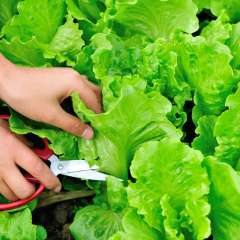Lettuce is a popular cool-season crop that is usually planted in the Spring and Fall. It is a great vegetable for beginning gardeners because it can be directly sown in the garden and requires very little fuss. Lettuce grows quickly and can be planted in succession so that you will always have some fresh greens available.
When to Plant Lettuce Seeds
Most lettuce varieties require cool temperatures to thrive. The ideal growing temperatures for lettuce are between 45° and 65°F. Lettuce seeds can be sown directly in the soil when temperatures are above 45°F in the early spring, or in a hoop house or greenhouse in late winter. You can get a head start and sow seeds indoors 2 to 4 weeks before your last frost date, but be sure to harden off the seedlings for a few days before planting outside.
Lettuce seeds are very small, so they should be sown into well-tilled soil with any large chunks removed (or otherwise aerated and prepped if you prefer no-till methods). Lettuce seeds need light to germinate, so plant them only about 1/8 inch deep. An easy method is to sow the seeds and then sprinkle a light coating of soil on top and use a mister to water the seeds into the soil, rather than a watering can or hose which might cause the seeds to wash away.
Lettuce rows should be planted about 12 to 15 inches apart. The distance between seedlings will vary depending on the type of lettuce. If your desire is for baby greens, you can sow seeds broadly and harvest en masse. Leaf lettuce should be thinned to 4 inches; cos (Romaine) and butterhead (Bibb) lettuce should be 8 inches apart, while head lettuce (Iceberg) should be 16 inches apart. Sow new seeds every 2 weeks for a continuous harvest.
Watering Lettuce
Keep seeds evenly moist but not wet. Lettuce will tell you when it needs to be watered. If the leaves are looking wilted, it’s time to water. Feel free to water any time of day, even at the warmest time, to help keep the leaves cool. When growing in warmer months, you might want to use row covers or plant in an area with indirect sunlight or afternoon shade to help prevent lettuce from drying out.
Three weeks after transplanting seedlings, you can fertilize your lettuce with a slow-release fertilizer to ensure plenty of nitrogen is available to the tender plants. Mulching around plants will help them retain moisture and nutrients as well.

When temperatures reach above 70°F, bolting can be a problem with lettuce. When lettuce bolts it produces a central stalk that will begin to flower. Once this happens the plant can become tough and bitter because it is shifting its energy to seed production. Shadecloth or row covers that provide filtered light can help delay bolting. You can also plant lettuce in the shade of taller companion plants like tomatoes.
Preventing Aphids and other Pests
Speaking of companion planting, your lettuce will reap the benefits of companion planting with alliums like onions, garlic, and chives. These will help keep aphids away. Slugs and cutworms also love lettuce. Sprinkling diatomaceous earth around seedlings after watering should help prevent those pests.
When to Harvest Lettuce
Lettuce grows quickly. Depending on the variety of lettuce that you grow, you can probably begin harvesting leaf lettuce at around 3 weeks. For head lettuce, harvest can begin around 6 to 8 weeks. The best time to harvest is during the early morning while the leaves are still crisp. With leaf lettuce, you can cut the larger outer leaves and leave the smaller inner leaves to continue growing, repeating this process for up to 2 months. With head lettuce, cut the head at the base about one inch above the soil and leave the roots in the ground. New lettuce will begin to grow in a couple of weeks.
How to Store Lettuce
Lettuce will last in the refrigerator for up to 10 days in a loose plastic bag. When you’re ready to use it, simply wash the leaves in cold water and dry them on a towel or using a salad spinner. If your lettuce is looking a little wilted, soak it in a bowl of ice water for 10 to 15 minutes to crisp up the leaves.
Lettuce is an easy-to-grow vegetable that is low in calories and an excellent source of vitamins, minerals, and helpful bioactive compounds. It is great for growing outdoors in cool weather and well adapted to growing indoors in hydroponic systems. There is a wide variety of colors and flavors of lettuce to choose from so you can grow multiple varieties to have exciting culinary choices.

























